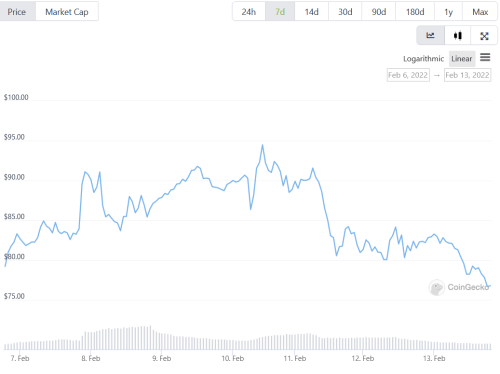Avalanche is an open-source, programmable smart contracts platform for decentralized applications. It’s proprietary token is called AVAX, and it’s used for transaction fees and staking.
Oddly enough, you don’t hear too much about Avalanche as an “ethereum-killer” but it’s got just as much claim to the odd little title as any other. It does much the same as Ethereum but at a lower price point. It powers a wide variety of applications including stablecoins, decentralized finance protocols like lending, savings and trading, and non-fungible tokens.
It’s also compatible with Solidity, the programming language used in Ethereum, which means developers can shift focus from ETH’s high gas prices and build on Avalanche, or maybe even use it to deploy custom private or public blockchains as subnets. There’s also the scaling factor—wherein Bitcoin can process about seven transactions a second and Avalanche pulls in about 4,500. Still a far cry from Visa or Mastercard, but it’s a start.
The AVAX Coin
AVAX is a staking coin, which means that consensus is gained through a variation of proof of stake. The dev-team here recognized that staking comes with its own loopholes and problems and they built in a few safeguards into the process to provide disincentives towards freeriding.
Here are a few takeaways from the AVAX economics model:
- The resources spent by a validator for staking are proportional to that validators total
stake.- The rewards accumulated by a validator for validating are proportional to that validators total stake.
- Since Avalanche is leaderless, there is no “rich-get-richer” compounding effects.
- Validators that lock their stake for longer are rewarded more.
- Validators are incentivized to stay online and operate correctly as their rewards are
based on proof-of-uptime and proof-of-correctness.- AVAX is a capped-supply token, with a maximum cap of 720 million tokens.
- While capped, $AVAX is still governable. The rate at which the maximum cap is reached
is subject to governance.- Fees are not paid to any specific validator. Instead, they are burned, thus increasing
scarcity of the $AVAX.
A few of the core problems with baseline proof-of-stake are that the folks with the most pre-existing coins to engage in staking will pull in the block reward more often than those that don’t. Basically, it’s a quick and easy way to ensure that the staking process eventually revolves around a handful of stakers, which get richer to the detriment of everyone else.
AVAX doesn’t work like that. That’s a good size draw because it means that you don’t have to hit the exchange and buy tens of thousands of dollars worth to get even the slightest twitch of a chance at closing the block.
Consensus Mechanism
There are generally two types of blockchain consensus: classical and Nakamoto.
Classical consensus requires all the nodes to communicate with each other on the network while Nakamoto relies on Proof-of-Work as well as longest chain formula. Longest chain formula generally being the longer the chain, the more likely it is to be valid.
Classical protocols often have low latency and high throughput and don’t scale to large numbers, nor are they particularly strong and resilient with membership changes. They’re generally used for permissioned blockchains and networks. Nakamoto consensus works well with new members, and can therefore handle the yield required of a public network, but suffer from confirmation latencies, low throughput, and have high energy requirements for the continued safety of the network.
The Snow family of consensus protocols combine the best parts of classical consensus protocols with the best of Nakamoto consensus. They achieve low latency (faster scaling) and higher throughput without requiring agreement on the precise membership of the system. Basically, there’s more flexibility when it comes to gaining consensus. This allows them to scale. They don’t use Proof-of-Work and therefore don’t eat up as much electricity.
The Snow protocols verify the contents of their blockchain the same way I got through seventh grade Math—by cheating off my neighbour. They operate by repeated sampling of the network with each node polling a small, constant-sized, random assortment of neighbours and switching its answer if a supermajority supports a different value.
The mechanism deals with a doublespend attempt through choosing among the conflict transactions and comparing them—every node will select a small subset of nodes and queries, which of the conflicting transactions the nodes think is the valid one. If the node doing the query receives a supermajority response in favour of one transaction, then the node changes its response to that transaction. Every node in the network does this procedure until the entire network comes to consensus on one of the conflicting transactions.
Basically, if they meet with conflicting data, then they go over it again and again until they come to a supermajority about which one is the right ledger. A supermajority is usually something like two thirds of all the nodes.
Perks:
Plenty of blockchains put out today are coming out with their own interactivity tools—generally, they include a blockchain explorer for coins, tokens and anything else happening on the Avalanche blockchain, and a wallet for easy storage. In this case, we have a third option. It’s the Avalanche Bridge, which acts as a portal between Ethereum and Avalanche, allowing for folks tired of paying high gas prices to port their Solidity-based code over to Avalanche and continue the work.
Performance:

At the time of writing Avalanche is the 12th largest cryptocurrency by market cap, trading at $76.79 with a market cap of $18.8 billion, a max supply of 720,000,000 and a circulating supply of 245,302,044.
—Joseph Morton
Full disclosure: The writer owns some AVAX.

